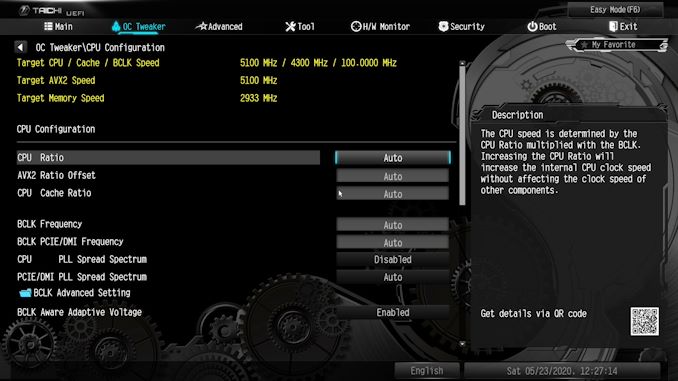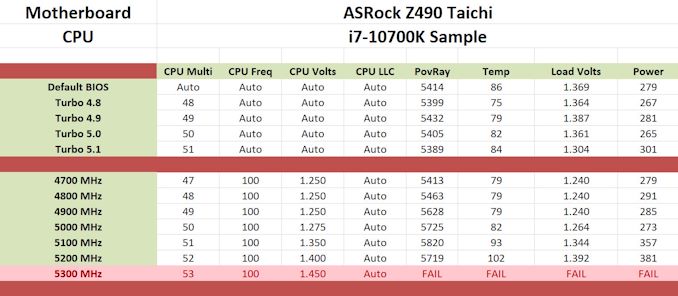The ASRock Z490 Taichi Motherboard Review: Punching LGA1200 Into Life
by Gavin Bonshor on May 27, 2020 9:00 AM ESTOverclocking
Experience with the ASRock Z490 Taichi
With Intel's 10th generation Comet Lake-S processors, overclocking on Z490 is very similar to Z390 in terms of settings and behaviour. The new processors run pretty hot under load and react differently depending on the quality of CPU cooler used. For optimal performance and based on our testing, it's recommended to use at least a 240 mm AIO with the Intel Core i7-10700K, with at least a 280 mm AIO on the Core i9-10900K. Despite Intel upgrading and refining its die through thinning and the use of soldered TIM, these still run toasty and with Intel's Thermal Velocity Boost adaptive up to 100 MHz extra when there's room for manoeuvre in temperature and power limits, better cooling should equate to better performance.
Overclocking using ASRock's Z490 Taichi firmware is a pleasant experience, with each of the three main overclocking segments (CPU, memory, Voltage) coming under its own menu within the OC Tweaker section. Provided with the firmware is four overclocking presets which range from 4.8 to 5.1 GHz with our testbed Core i7-10700K processor, which we have tested below. Users looking to overclock the CPU can simply increase the CPU Core ratio which goes up and down in 100 MHz increments, while voltage options for CPU VCore can be found within the voltage settings.
Memory overclocking can be done with a couple of clicks when using XMP 2.0 memory profiles, or users can customize these within the memory settings section. One thing of note is ASRock offers a wide variety of latencies for users to tweak, which can increase performance providing the memory has enough headroom for increase frequency, and the ability to run with tighter latencies. The ASRock Z490 Taichi firmware is stable to use, responsive (version 1.50), and aesthetically simple and pleasing.
Overclocking Methodology
Our standard overclocking methodology is as follows. We select the automatic overclock options and test for stability with POV-Ray and Prime95 to simulate high-end workloads. These stability tests aim to catch any immediate causes for memory or CPU errors.
For manual overclocks, based on the information gathered from the previous testing, starts off at a nominal voltage and CPU multiplier, and the multiplier is increased until the stability tests are failed. The CPU voltage is increased gradually until the stability tests are passed, and the process repeated until the motherboard reduces the multiplier automatically (due to safety protocol) or the CPU temperature reaches a stupidly high level (105ºC+). Our testbed is not in a case, which should push overclocks higher with fresher (cooler) air.
Overclocking Results
Overclocking an Intel Core i7-10700K using the ASRock Z490 Taichi was a pleasurable one with plenty of headroom and capability shown from the motherboard itself. We tested the four overclocking presets which range from 4.8 to 5.1 GHz, with some interesting results. The Turbo 4.8 profile actually performed a little worse in our POV-Ray testing than default settings, albeit with a lower heat threshold. The Turbo 4.9 and 5.0 profiles also didn't improve much compared with the default settings, which shows ASRock's default profile is quite aggressive. Testing the top Turbo 5.1 profile, it actually performed the worse in our POV-Ray testing, which also strangely presented us with the lowest load CPU VCore voltage readout.
Dialling in manual overclocks, we started at 4.7 GHz and extended this to 5.3 GHz. Overclocking on the ASRock Z490 Taichi at 4.7 GHz all-cores, we saw similar performance to stock, albeit with lower temperatures, but identical power draw. Going from 4.8 to 5.2 GHz proved effective in increasing performance which went up incrementally, along with the temperature. Power draw was a little inconsistent in this range with our 5.0 GHz test outputting lower power than at 4.7 GHz. The best overclock we could manage with 1.4 V on the CPU VCore was 5.2 GHz all-cores which performed slightly worse than 5.1 GHz, which could be put down to an anomaly, but power draw reached 381 W which is quite staggering and difficult to cool, even with our NZXT Kraken Z63 280 AIO Cooler. When changing the CPU Vcore to a defined amount, it would automatically change the LLC profile to level 1, which attributes to tighter and consistent VDroop when under load.
Overall it was easy to overclock with the ASRock Z490 Taichi and despite a couple of anomalies and inconsistencies in power draw and our POV-Ray results, there doesn't seem to be anything untoward or that would hinder the board's ability to overclock any of the Intel Comet Lake 10th gen processors, other than the heat generated of course.












57 Comments
View All Comments
lmcd - Wednesday, May 27, 2020 - link
Honestly this is the most inane post I've ever read. Times haven't changed for the better, Raven Ridge support took over a year after the SoC was released. I own two Raven Ridge devices. I would know.Even when AMD support hits mainline, it's in such a late kernel version that you better hope this "sane" distro you're referring to is willing to backport support in an update.
Dunno what you mean about the Nvidia driver being painless to use. Its Wayland support is still comparatively unstable in Gnome and pushes KDE Wayland support from mediocre to bad. It also requires extra build tools.
I can't edit posts but I explained a key usage of nested Hyper-V. "Anyone who wants to use the Windows 10X emulator needs it unfortunately." There's also plenty of other features that use Hyper-V these days from WSL2 to Windows Sandbox, so the antiquated views on Hyper-V are also quite dated. Times have changed for the better, and Hyper-V is very much part of the present.
Congrats on your condescension though! It almost masks how wrong you are.
Dug - Wednesday, May 27, 2020 - link
Why in the world do you insist on benchmarking Non-UEFI POST Time when no one will use that?TheinsanegamerN - Thursday, May 28, 2020 - link
Because not everyone is you and there are those of us that DO use it. Wow, what an amazing thought.Dorkaman - Thursday, May 28, 2020 - link
I would love to see UEFI post time AND Windpows clean knstall boot time. My old Asus Rampage V Extreme was very slow (40s post+boot no mem test hybrid) and the new Asus ROG Maximus XII Extreme is also very slow.My Gigabyte Z390 Aorus Master posts+boots in 10+5 seconds.
Dug - Wednesday, June 3, 2020 - link
Why would you be buying new equipment for outdated OS's that aren't supported?If that's the case, the boot time is irrelevant, and my post still stands. Why even bother benchmarking it?
Ranger1065 - Wednesday, May 27, 2020 - link
A good read, always a pleasure to peruse Anandtech. The aesthetics are not for everyone but personally I think it's a nice looking board. Out of my price range but Z490 is not for me anyway. As to Asus boards, I have an older Z97 Maximus Hero VII and a Z390 Prime. Both great boards that have given me no significant issues.Jorgp2 - Wednesday, May 27, 2020 - link
Do the new CPUs have an additional 4x lanes from the CPU?I keep seeing boards that advertise 8,8,4 slots, with all of them coming from the CPU. And this motherboard for example that has the 4x gen 4 M.2, when the chipset does not have Gen 4
MDD1963 - Wednesday, May 27, 2020 - link
The specs I read said the top GPU slot would be capable of PCI-e 4.0 x16, ...and one of the M.2 slots...( perhaps I missed where it said all 4 might be capable fo PCI-e 4.0 x4 operation?_)Even with the aforementioned limits, more than enough for 99% of most folks....
Spunjji - Thursday, May 28, 2020 - link
Waiting to see how many people show up to the comments to wail about the tiny fans. After all, it wasn't anti-AMD sentiment that caused so many folks to show to all of the articles related to X570 boards (and a few that weren't) and do that, it was totally neutral concerns about longevity and noise.(Full disclosure - I am fully on-board with not wanting tiny fans on a motherboard... just feeling a little amused by the asymmetry of this. The only comment here so far on this topic has been a sensible one, not hysterical ranting.)
TheinsanegamerN - Thursday, May 28, 2020 - link
So you smugly, disingenuously re-categorize the arguments of others and think you're...clever? Funny? Intelligent?Now, here's points for asrock that might blow your mind, these are STANDARD FANS. You can go buy brand new noctuas to replace these and silence them while maintaining cooling performance. Guess what you couldnt do with x570 chipset fans? These fans also dont spin 24/7, only when needed, and the VRMs here get a LOT hotter then the x570 chipset did.
If X570 got into the 90C range without the active cooling (it doesnt) and they used standard 40mm fans (they dont) then the complaints would be baseless. But we saw how necessary those x570 fans really were. And oh hey, there are plenty of Z490 mtoherboards that dont use VRM fans! Just like that whole 1 X570 motherboard that cost like $700!